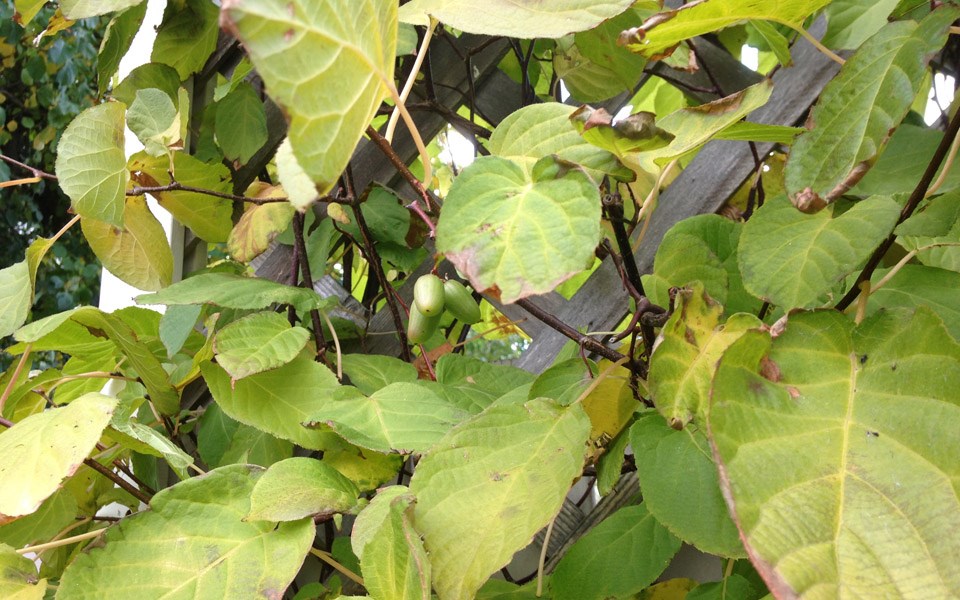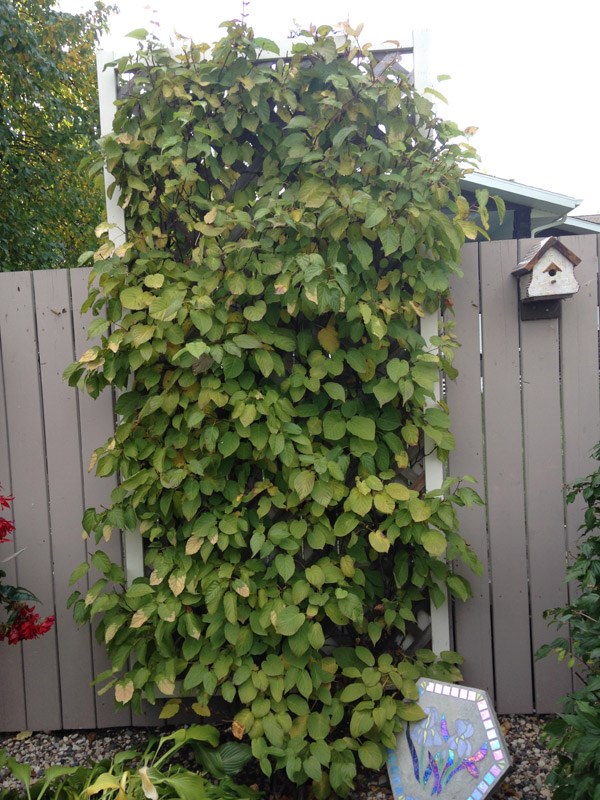Vines can be used to beautify a vertical garden structure, provide privacy, take advantage of vertical space when horizontal space is limited or cover a large space with one plant. Every situation is unique and sometimes it may seem that we lack vine options in our climate; however, there are alternatives available.
One of the most common perennial vines found in the prairie landscape is the Virginia creeper (Parthenocissus quinquefolia). This hardy vine will cover a fence or horizontal structure in several years from planting. The leaves are palmately compound with five leaflets. Although the flowers and tiny fruit are insignificant, when grown in a sunny location, the red foliage colour in the fall can be spectacular.
‘Dropmore Scarlet Honeysuckle’ is a fine-textured vine compared to the Virginia creeper. The roundish blue-green leaves provide a beautiful backdrop for the prolific and beautiful scarlet colored, trumpet-shaped flowers that bloom from early to mid-summer. The flowers attract hummingbirds and the small red berries that ensue are a favourite food for birds.
There are many types of clematis vines available for growing in the garden. Always check the hardiness zone when purchasing a clematis to survive the Prairie climate. Clematis need a structure to grow vertically since its vine twists around the structure as it grows. ‘Jackmanii’ is a vigorous-growing clematis with profuse, dark purple flowers that bloom during the summer. ‘Jackmanii’ is recommended for zone 4: protect the roots in our climate with extra mulch in the fall. ‘Nelly Moser’ is another clematis recommended for zone 4; however, its flowers are bright pink and the bloom time is early summer.
‘Prairie Traveler’s Joy’ is a hardy clematis developed by Dr. Frank Skinner out of Manitoba. This clematis is not like the large flowering clematis previously mentioned; however, it is drought tolerant and will fill in a horizontal space where other plants may find it difficult to grow. The starry white flowers are only two centimetres across and bloom later in the summer; however, the clusters of flowers provide an attractive display at this time of the year. Considered invasive in some parts of the United States, be prepared to keep this plant in check. ‘Rosy O’Grady’ clematis was also released by Dr. Skinner. Recommended for zone 3, ‘Rosy O’Grady’ has pink, bell-shaped flowers which appear in late spring, followed by attractive seed heads in summer. ‘Joe Zary’ clematis is a double flowering purple clematis bred on the Prairies by Mr. Stan Zubrowski. This clematis blooms in late spring/early summer and is one of the hardiest for the Prairies.
When considering vines, one must include grapes in the possibilities. Vitis riparia, commonly known as the riverbank grape, is found throughout North America in moist areas such as riverbanks. Riverbank grape is a large, multi-stemmed vine that produces small fruits that are tasty for birds, not so much for humans.
For the Prairie climate, the most hardy edible grape vines to grow are ‘Valiant’ and ‘Beta.’ Both grape types produce dark blue clusters of grapes that are ready to harvest in early September. The grapes are a little small for fresh eating; however, they are highly recommended for juice, jams and jellies. Of the two cultivars, ‘Valiant’ is considered more cold-hardy than ‘Beta’.
Other fruit-producing vines that should be considered in the Prairie garden include kiwis and hops.
The kiwi fruit that will be produced on Prairie hardy vines are much smaller than the kiwi fruit you can purchase at the grocery store (two to four centimetres compared to seven to 10 centimetres). To produce kiwi fruit, plant both a male and female kiwi vine. Expect to harvest a few fruit within three to four years and by the seventh or eighth year, hopefully, you will have enough fruit to fill a four-liter pail.
Kiwi vine growing on a trellis structure along a fence. | Photo by Jackie Bantle
Hops (Humulus lupulus) are an aggressive vine that requires a support to grow vertically. Even if you don’t want to make your own beer from the fruit, hops are an attractive, interesting plant that provide an excellent privacy screen. Hops die back to ground level each winter and spring back to life at the start of each growing season, growing up to six metres in one season.
A unique vine that is an excellent talking point in the garden is ‘Dutchman’s Pipe’ (Aristolochia macrophylla). This vine requires a trellis or structure for support. It gets its name from the four to five centimetre long yellowish-green flowers that resemble a Dutchman’s pipe. ‘Dutchman’s Pipe’ is recommended for Zone 4 and will require a protected location or extra winter mulch for the Prairies.
American bittersweet (Celastrus scandens) is a woody vine native to North America that produces orange-red fruit that attracts birds in fall and winter. Both a male and a female vine are required for fruit production. Leaves turn an attractive bright yellow in fall. Do not confuse American bittersweet with Oriental bittersweet (Celatrus arbiculatis), which is similar but a highly invasive vine.
Whether you decide to grow a grape, hops or American bittersweet, always put the supporting structure in place BEFORE planting your vine. Think about how big your vine is going to get in the future and be sure that your support structure is strong enough to support the mature plant. Happy gardening!
This column is provided courtesy of the Saskatchewan Perennial Society.
(SPS; [email protected]). Check our website () or Facebook page () for a list of upcoming gardening events.





